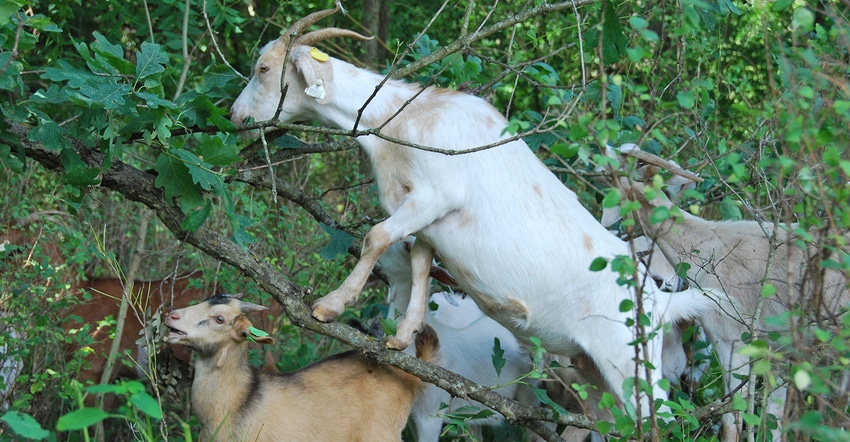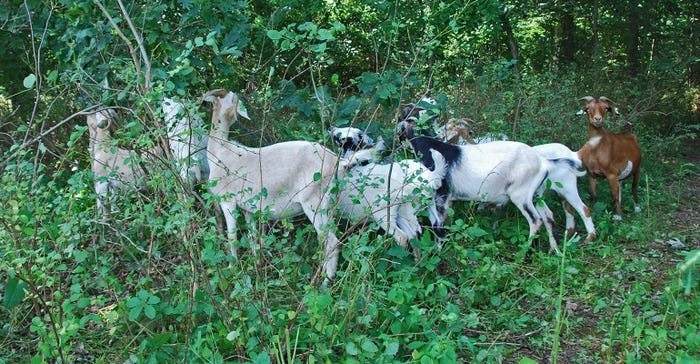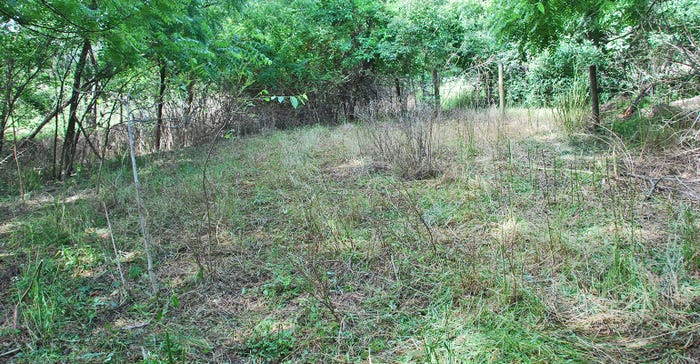August 16, 2017

By Charlie Rahm
Jerad and Emily Cummins and their young children found the herd of goats that inhabited the woods at their Ray County home near Lawson to be quite entertaining. The goats weren't there for entertainment value, though. They had a job to do: devouring invasive understory brush.
Jerad Cummins had 12 acres of woods that were from 50% to 85% filled with brush-like bush honeysuckle, autumn olive and multiflora rose. He worked with Matt Arndt, a forester funded by the USDA's Natural Resources Conservation Service, to develop a forest management plan outlining steps to restore the woods to a more natural state. NRCS also had approved his application for financial assistance to implement the plan. The first step was to open up the understory.
"We didn't care for a chemical option," Jerad says. "We walk in the woods. The kids play in the woods. We hunt and fish the property."

HEALTHY APPETITE: Eating invasive plant species makes goats ideal for landowners who do not want to use chemical control. The Natural Resources Conservation Service has funding help for landowners.

Quick work
So instead of spraying the plants, he contracted with an Iowa company to bring in a herd of 358 goats to graze the woods. The goats, eating at a rate of 1 ton of brush per day, cleared the 12 acres of undergrowth in two weeks.
"We feel like the goats took off last year's growth, this year's growth — and stunted next year's growth," says Aaron Steele of Goats on the Go. He says the goats will be brought back twice more next year to further stunt the brush.
The Cummins family was enamored of the group of grazers. "We've just been so impressed by the goats," Jerad says. The animals work as a team to bend over and eat a bush honeysuckle plant. "We like to come out and watch them," he says. "They kind of move through the woods like a school of fish."

ALL GONE: A group of 358 goats cleared 12 acres of brush in just two weeks.

Problems with plants
Nate Goodrich, NRCS state forester, says that removing invasive plants from the understory is a critical first step for forest improvement.
"If you thin the overstory without controlling the invasives, the increased sunlight on the forest floor helps the invasives spread," Goodrich says.
Once the goats have done their job, Jerad will manually remove any new invasive plant sprouts before they have a chance to grow. A thinned understory and canopy will give native plants like oaks, dogwoods and redbuds a chance to recover. The hoped-for results are a well-maintained, natural woods instead of something resembling a jungle.
"One of the best things about goats is their ability to help a landowner get a foothold on a problem that they thought was insurmountable," Steele says.
Funding source
Jerad feels fortunate that NRCS has a program that allows him to help the forest resource in an environmentally friendly way.
"The good thing about the goats is that they are low-impact," he says. "For us, the goats would not be an option if NRCS were not involved, because it would be cost-prohibitive."
J.R. Flores, state conservationist, says the brush management approach on Jerad's property is an example of how NRCS works with landowners to improve natural resources in ways compatible with the landowners' wishes.
"We have several financial assistance programs to help landowners improve the resources on their land," Flores says. "Our goal with providing the technical assistance associated with the programs is to work with the landowners to get the job done as closely as we can to the way they would prefer."
The place to start is a trip to a local USDA Service Center, where NRCS professionals can explain potential options.
Sometimes, as the Cummins family can attest, the fix can be both effective and entertaining.
Rahm is a public affairs officer for USDA NRCS in Columbia.
You May Also Like




